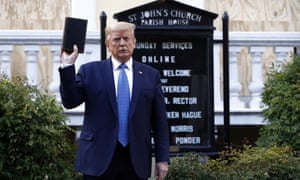Trump’s decision to walk to St John’s to be photographed with the Bible was another extraordinary decision made on the hoof
- George Floyd killing – latest US updates
- See all our George Floyd coverage

Photograph: Patrick Semansky/AP
Early one Saturday morning in May 1970, Richard Nixon, under enormous pressure, left the White House, seeking to talk to people protesting against the Vietnam war around the Lincoln Memorial. It was a strange moment in American history but a hugely symbolic one, foreshadowing a president’s fall.
Fifty years later, on a Monday afternoon in early June, Donald Trump also walked out of the White House. But his route was very different and went through Lafayette Square. Moments before, peaceful protesters, priests and families among them, had been assaulted by national guardsmen and federal officers: gassed, shot with rubber bullets, forcefully cleared from the president’s path.
With a small group of aides, his daughter Ivanka among them, the president walked to St John’s, the so-called Church of the Presidents, to be photographed by the press, holding aloft a Bible.
The president had ordered an assault on his own citizens, in order to stage a PR stunt. Like many momentous decisions in an extraordinary presidency, it was a call made on the hoof.
George Floyd, a 46-year-old African American man, was killed by police in Minneapolis on Memorial Day, 25 May, just a week before. Peaceful protests against police brutality and racism followed, and spread. Over the weekend, in the face of violently aggressive policing, many protests were marred by chaos and looting.
Trump did express sympathy with protesters, including in public remarks in Florida. But by Sunday he had disappeared from view.
On Friday night, as protesters clashed with police and Secret Service agents outside the White House, Trump hid in an underground bunker. It was reported that he did not speak on Sunday because he had nothing constructive to say. Floyd’s brother said a call from the president went badly, Trump seemingly unwilling to let him speak. The White House lights went off.
All this landed on top of the president’s long-brewing frustration with coverage of his handling of the coronavirus pandemic, in which more than 105,000 Americans have died and 40 million have filed for unemployment in a stricken US economy.
And so, the Washington Post reported, on Monday morning Trump began to consider a visit to St John’s. Every president since James Madison has worshipped there. It is a national treasure. On Sunday, as protest churned, it was briefly threatened by fire.
The president wanted to show Washington was under his control. He also wanted to reassure a key bloc of support. Polls have shown that among white evangelical Christians, as the campaign against Joe Biden heats up, backing for Trump is slipping.
There was also other business to be conducted: a conference call with governors. Trump used it to taunt political opponents, rant about the need to dominate protesters, call for mass arrests and threaten to call in the army. Tellingly, he said: “Washington was under good control, but we’re gonna have it under much more control … we’re gonna clamp down very, very strong.”
The call promptly leaked to media outlets, the Guardian among them.
As controversy spread, according to the Axios website, advisers “hotly debated” whether Trump should finally address the nation. Some argued not, saying he could change nothing. Some insisted he had to be seen. Finally, Trump tweeted that he would speak in the White House Rose Garden.
“I am your president of law and order,” he said at the podium, striking a firmly Nixonian note, as he has on the campaign trail.
“We are ending the riots and lawlessness that has spread throughout our country. We will end it now.”
As the president declared himself “an ally of all peaceful protesters” his audience could hear the sound of battle in Lafayette Square, flash-bangs detonating, teargas hissing. TV viewers could see both images in split screen. As Trump left the White House grounds, social media began to spew a fog of anger and division as thick as the clouds which enveloped protesters.
Fox News approved. But one unnamed Trump aide doubted the long-term impact of the president’s move.
“It was just to win the news cycle,” the aide told the Post. “I’m not sure that things are any better for us tomorrow.”
Speaking anonymously, another senior White House official told Axios they had “never been more ashamed”.
“I’m really honestly disgusted,” the official said. “I’m sick to my stomach.”
The bishop of Washington was outraged. Pundits were swift to agree.
Joe Lockhart, a press secretary for Bill Clinton now an analyst for CNN, tweeted: “I lived through Martin Luther King Jr and Bobby Kennedy being assassinated, our cities burning, Watergate, 9/11 and other national tragedies. I’ve never been so frightened for our country as I am tonight. Trump has to go now.”
As Monday night bled into Tuesday morning, Washington was largely peaceful, under curfew, helicopters buzzing overhead. But across the US, other protests continued. In some cities, New York and Philadelphia prominent among them, violence and looting continued.
On Tuesday morning, as after many an unprecedented moment since 2016, Americans read the news, tweeted their horror or support, then went back to watching for Trump’s next move.
The president’s inner circle, said another senior official who spoke to Axios, were “all celebrating” the events of Monday.
“They’re very, very proud of themselves,” they said.
Another top aide was reported to be boasting of a political coup, an “iconic” moment in America under Trump.



